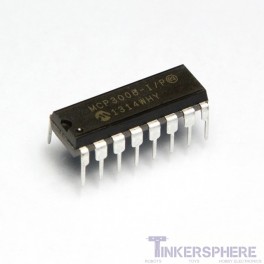 Maximize
Maximize Analog to Digital Converter for Raspberry Pi: MCP3008
Use this MCP3008 Analog to Digital Converter to add 8 Analog Inputs to your Raspberry Pi or other microcontroller!

Categories
Newsletter
 Maximize
Maximize Use this MCP3008 Analog to Digital Converter to add 8 Analog Inputs to your Raspberry Pi or other microcontroller!
This Analog to Digital Converter takes in up to 8 analog inputs and outputs them digitally using the SPI protocol(this means it requires only 4 digital pins on your microcontroller to read all 8 analog inputs). Just hook up this Analog to Digital Converter to your Digital Microcontrollers such as the Raspberry Pi, and you will have 8 analog inputs with 10-bit accuracy!
Specifications: